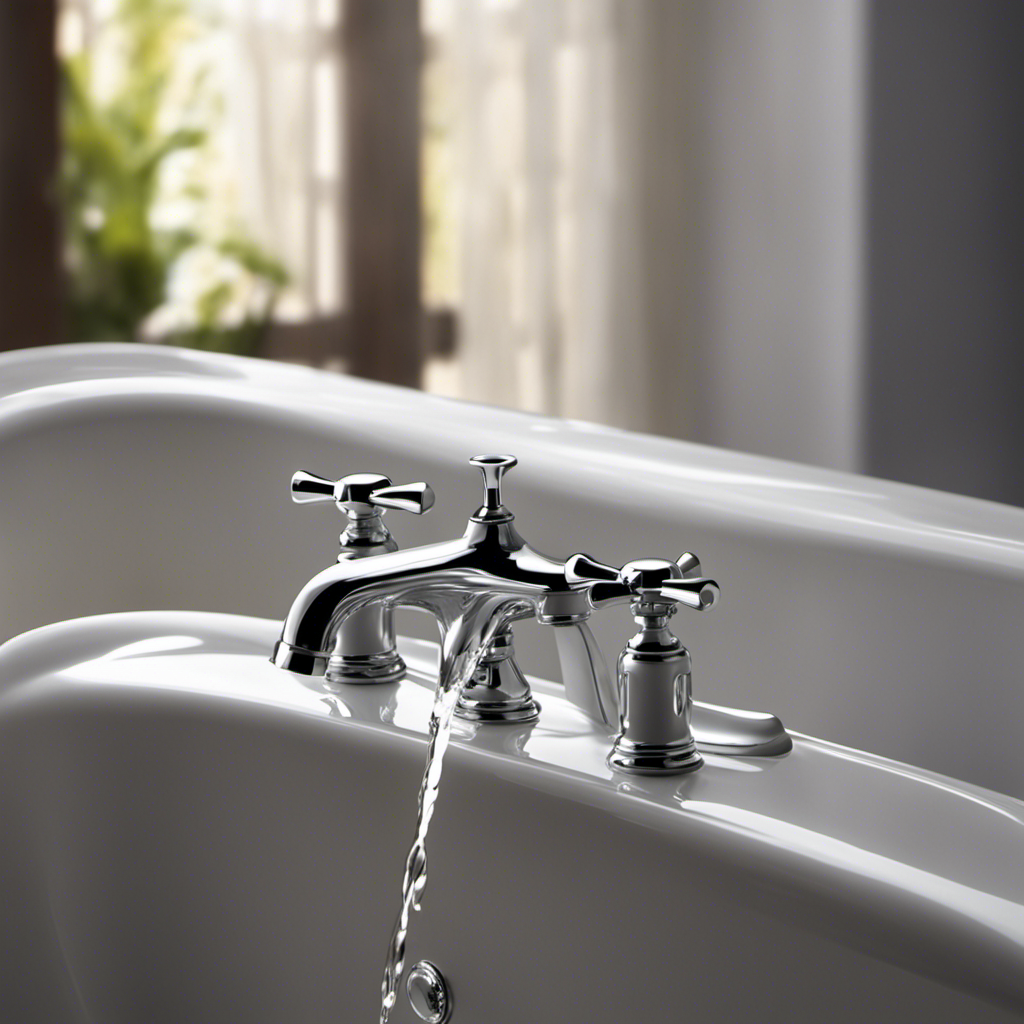As I stand in my bathroom, staring at the worn and faded bathtub, I can’t help but feel a sense of renewal. It’s time to give this old fixture a fresh coat of paint, and I want to make sure I choose the right one.
So, what paint should I use on a bathtub? In this article, I will guide you through the various types of paint suitable for bathtub surfaces, factors to consider when making your selection, and provide a step-by-step guide on how to prepare and paint your bathtub like a pro.
Get ready to transform your bathroom with a simple yet impactful DIY project.
Key Takeaways
- Epoxy paint and acrylic paint are suitable options for painting bathtubs, providing durability, water resistance, and a smooth finish.
- Bathtub refinishing kits, such as Rust-Oleum Tub and Tile Refinishing Kit and Homax Tough as Tile Tub and Sink Refinishing Kit, offer cost-effective options using epoxy or acrylic paint.
- DIY bathtub painting is a cost-effective choice, allowing the freedom to choose color and finish, but it requires thorough preparation and surface cleaning, as well as potentially multiple coats.
- Proper preparation is essential when painting a bathtub, including cleaning the surface with a mild abrasive cleaner, removing old paint, and wiping down the surface to remove dust and debris.
Types of Paint Suitable for Bathtub Surfaces
There are a few types of paint that are suitable for bathtub surfaces. When it comes to bathtub paint colors, epoxy paint is a popular choice. It is durable and resistant to water and chemicals, making it perfect for withstanding the wear and tear of daily use in the bathroom.
Another option is acrylic paint, which is also water-resistant and provides a smooth, glossy finish. It is available in a wide range of colors, allowing you to choose the perfect shade for your bathtub.
If you’re looking for cost-effective bathtub painting options, consider using a bathtub refinishing kit. These kits typically include epoxy or acrylic paint, along with all the necessary tools and instructions.
Transitioning into the next section, it’s important to consider certain factors when choosing paint for a bathtub.
Factors to Consider When Choosing Paint for a Bathtub
When choosing the right paint for your bathtub, it’s important to consider factors such as durability, moisture resistance, and ease of application. Here are some key points to keep in mind:
-
Popular bathtub paint brands:
-
Rust-Oleum Tub and Tile Refinishing Kit
-
Homax Tough as Tile Tub and Sink Refinishing Kit
-
Pros of DIY bathtub painting:
-
Cost-effective compared to hiring professionals
-
Gives you the freedom to choose your desired color and finish
-
Cons of DIY bathtub painting:
-
Requires thorough preparation and surface cleaning
-
May require multiple coats for complete coverage
Considering these factors, it is essential to choose a paint that is specifically designed for bathtub surfaces to ensure long-lasting results. Now that we understand the importance of selecting the right paint, let’s move on to the step-by-step guide on preparing the bathtub for painting.
Step-By-Step Guide on Preparing the Bathtub for Painting
To properly prepare your bathtub for painting, start by thoroughly cleaning the surface using a mild abrasive cleaner. This will help remove any dirt, grime, or soap scum that may be present. After cleaning, rinse the bathtub thoroughly and allow it to dry completely. Next, if there is any old paint on the surface, it is important to remove it before applying a new coat. This can be done using a paint scraper or sandpaper. Make sure to wear protective gloves and a mask to avoid inhaling any dust or fumes. Once the old paint is removed, wipe down the surface again to ensure it is clean and ready for painting.
Here is a table to help you visualize the steps:
| Step | Action |
|---|---|
| 1 | Clean the surface with a mild abrasive cleaner |
| 2 | Rinse the bathtub and let it dry |
| 3 | Remove any old paint using a paint scraper or sandpaper |
| 4 | Wipe down the surface to remove any dust or debris |
Application Techniques for Painting a Bathtub
For a professional finish, make sure you follow proper application techniques when painting your bathtub.
It’s important to start with a clean and well-prepared surface, as discussed in the previous subtopic on bathtub surface preparation.
Here are some key tips to keep in mind when applying paint to your bathtub:
- Use a high-quality brush or roller specifically designed for painting bathtubs.
- Apply thin and even coats of paint to avoid drips and streaks.
- Allow each coat to dry completely before applying the next one.
- Make sure to cover all areas evenly, including hard-to-reach spots.
- Take your time and be patient throughout the painting process.
By following these techniques, you can achieve a smooth and professional-looking finish on your bathtub.
Avoiding common mistakes, such as rushing or applying too thick of a coat, will ensure a long-lasting and visually appealing result.
Tips for Maintaining and Prolonging the Lifespan of Bathtub Paint
If you want to maintain the longevity of your newly painted tub, it’s essential that you implement proper maintenance techniques.
One of the most common mistakes to avoid when painting a bathtub is using abrasive cleaners or scrub brushes, as they can damage the paint finish. Instead, opt for gentle, non-abrasive cleaners and soft cloths or sponges for cleaning.
Regularly cleaning your painted bathtub is crucial to prevent the buildup of dirt, grime, and soap scum. After each use, rinse the tub with warm water and wipe it dry to prevent water spots. Avoid using harsh chemicals or bleach, as they can fade or discolor the paint.
To protect the painted surface, consider applying a clear topcoat every few years.
Frequently Asked Questions
How Long Does the Paint on a Bathtub Typically Last Before It Needs to Be Repainted?
Typically, the paint on a bathtub lasts around 5-7 years before needing to be repainted. To ensure longevity, it’s crucial to properly prepare the surface by cleaning, sanding, and priming. Regular maintenance is also important to prolong the painted surface’s lifespan.
Can I Use Regular Wall Paint on My Bathtub Instead of Specialized Bathtub Paint?
Using regular wall paint on a bathtub instead of specialized bathtub paint may not provide the best results. Specialized bathtub paint has benefits like durability and resistance to water damage. Properly preparing the surface before painting is crucial.
Is It Necessary to Remove All the Old Paint From the Bathtub Before Applying a New Coat?
Is it necessary to remove all the old paint from the bathtub before applying a new coat? Removing old paint is essential as it ensures proper adhesion. The best tools for bathtub painting include sandpaper, a scraper, and a good quality primer.
Can I Use a Brush or Roller to Apply the Bathtub Paint, or Is Spraying It on the Only Option?
I find that using a brush or roller to apply bathtub paint gives me more control and precision. However, spraying the paint can provide a smoother finish. It’s also worth considering alternative methods like sponge or foam applicators.
Are There Any Specific Cleaning Products or Techniques I Should Avoid Using on a Painted Bathtub Surface?
When it comes to protecting a painted bathtub, it’s important to know which cleaning products to avoid. Harsh chemicals and abrasive cleaners can damage the paint. Instead, opt for gentle cleaners and non-abrasive sponges to keep your bathtub looking its best.
Conclusion
After considering the different types of paint suitable for bathtubs and the factors to consider when choosing the right one, I embarked on the step-by-step process of preparing my bathtub for painting.
With careful application techniques, I transformed my worn-out tub into a stunning centerpiece of my bathroom.
But the real question remains: will the paint withstand the test of time? Only time will tell, but with proper maintenance and care, I’m hopeful that my newly painted bathtub will continue to shine for years to come.










